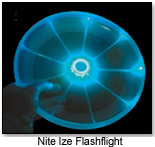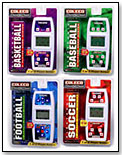|
|
Look, Ma! Electrons! Electronic Toys for the Holiday Season
Jan Greenspan, vice-president of sales, NITE IZE, thinks that a key to Blue Box Toy’s Mi-Jam line would seem to bear out Greenspan’s insights. They take “commonplace” musical instruments and iPod them. As Andrea Nicastro, associate publicist for SSA Public Relations (who work with Blue Box Toy) explains: “Teens and tweens of today are totally engaged in entertainment and music and they all aspire to be part of the scene. The Mi-Jam products are easy to use and compatible with iPods, mp3 players and other media devices that are exploding into the market. With mi-Jam there is ease of recording and podcasting and users do not need complex equipment.” Taking social games and bringing them into the digital age is another method that seems to translate in the toy world. “Toys or games that inspire creativity and social interaction tend to be played with more often,” explained Nancy Jenkins, director of public relations for Screenlife LLC. “When you can get your friends and family involved, you have a winner.” The success of Screenlife games seem to bear that out, and the newest Screenlife American Idol-All Star Challenge DVD Game leads the way. ZAPiT Games’ very goal revolved around social “play”: It was ... “to design a gaming system that meets the needs of today’s interactive social experience.” Jeff Hurst, vice president of sales and marketing for ZAPiT Games, had this to say: “What makes a great game is being able to integrate classic game concepts with today’s technology to add some spice to the traditional game play experience. Game Wave is unique in that it restores a social dimension to games. It combines the group interaction of traditional board games with the excitement of interactive video that encourages family interaction — something hard to find in other electronic games. People find they just have to talk and laugh with each other during play.” Ken Fong, vice president of marketing for The B Equal Company points out that the “one thing that makes us different is that our products are for all ages. It’s easy to target a particular age group, harder to get an entire family together. What we do is make our games quick enough so that the younger kids get the action and the pace they need, but also it’s intellectually stimulating enough for the parents to be interested. Most have dynamic leveling — a patent pending feature we have. Even though a DVD movie player is a dumb device, we can make the questions harder and harder if right, or easier and easier if wrong. If you have a 6 year old, they get true/false for kindergarten level, whereas the parent will get the really hard questions if they’re getting it right.” Eric Levin, executive vice president at Techno Source, explained that “the industry gets too focused on categorizing toys as ‘traditional’ or ‘electronic’. Kids don’t think that way. They categorize toys as either ‘fun’, or ‘not fun!’ Electronics alone won’t make a toy better. In fact, sometimes they can make the toy worse. Use electronics only because a toy needs it to enable the play pattern or take a play pattern to the next level, and you will have a good chance for a strong selling item.” As for the latest and greatest? “We’re very excited about our ‘Spiderman 3’ lineup, although working on the products has been a challenge at times; we have to start the process much earlier than non-electronic categories in order to have time to do the programming. Even though we’ve read the script and seen a lot of photography, they’re still in principal photography and some of what we know now could be left on the editing floor.” Chris Wilson, vice president, marketing for Radica Games thinks that “What makes a toy a toy is that imagination and creative thought goes into its development and/or its use. The objective of a toy with or without electronics is to engage a child as he or she interacts through basic play patterns. The addition of electronic features should enhance the play experience. While there is always a time and place for traditional game-play, adding electronics to traditional games raises the fun factor for kids. The level of electronic innovation and style makes our toys more than wires and silicon chips. It makes them challenging, stimulating and most of all fun! Kids today are early adapters, expecting a quick turnaround on new and improved technology. Successful electronic toys are relevant to their lives and lifestyles, entertain them and are authentic. They aren’t made to replicate the real thing; they are the real thing.” Creative use of technology, social play, a new use for an old idea, innovation. These are what make an “electrifying” electronic toy.
Writer's Bio: Mark Zaslove is an entertainment industry veteran in developing content (writing, directing and producing television and feature films) for the major studios, including Disney, Universal and Warner Bros. A two-time Emmy Award winner for writing and recipient of the Humanitas Prize (for writing uplifting human values in television and movies), Mark is also Head of Content Development for Nice Entertainment. Read more articles by this author
|
| ||||||||||||||||||||||||||||||||||||||||||||||||||||||||||
Disclaimer Privacy Policy Career Opportunities
Use of this site constitutes acceptance of our Terms of Use.
© Copyright 2026 PlayZak®, a division of ToyDirectory.com®, Inc.

 successful electronic toys is to “t
successful electronic toys is to “t






